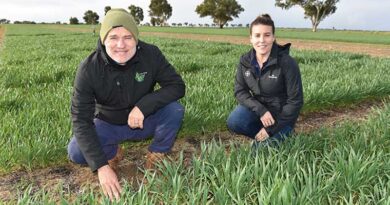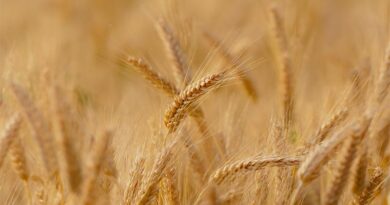New herbicide strategy adds punch to weed fight
21 February 2024, AU: A move to wider seeding row spacings, allowing higher application rates of pre-emergent herbicides to be utilised, and the addition of a new herbicide strategy has proved a powerful one-two punch in the tough fight against weeds for the Preston family in Western Australia’s northern wheatbelt.
Brothers Bob and Murray Preston grow predominantly wheat and lupins, as well as canola and barley. Their properties, ‘Muranda Plains’ are on sandplain country, situated 80 kilometres east of Geraldton in the south-west corner of the Mullewa Shire.
Some land had been cropped to mainly wheat and lupins for 56 years. The continuing use of herbicides from the same or related chemistry groups has caused weed control challenges, including reduced herbicide efficacy when targeting annual ryegrass and wild radish.
In the last two seasons however, the Prestons have widened the row spacings on their John Deere paired-row seeding bars from 17.5 centimetres to 25 cm. They also added to their toolbox a herbicide that can be applied at the early post-emergent (EPE) crop timing, Mateno® Complete.
Targeting mainly the annual ryegrass in high weed pressure paddocks, the use of Mateno Complete followed the pre-emergent application of trifluralin, which has typically been applied for grass weed control, along with prosulfocarb.
“Mateno Complete worked in really well with our transition to 10-inch spacings and after so many years of continuous cropping and herbicide use, you are always looking for a new edge to bring into the rotation.”
Mateno Complete, which can be incorporated by sowing or applied EPE in wheat and barley, contains aclonifen, a herbicide mode of action available last season for the first time to the Australian industry, in a unique, complementary co-formulation with pyroxasulfone and diflufenican herbicides.
Up against tough weed populations and the challenge of controlling weeds on some non-wetting sandplain soils, the Prestons have been applying the highest label rate of Mateno Complete EPE in wheat.
“We applied it early, mixed in with bromoxynil and Logran® to pick up early radish and volunteer legumes. Traditionally we have been applying a radish herbicide early anyway, so the fact we can now add it in with Mateno Complete as well, it works together, and we seem to be getting a really good job out of that,” Bob said.
“The tank mixing was also quite good. There was no antagonism and very little crop effect over both years. There was a little bit of discolouration in the crop, but nothing compared to some other chemistry. It grows out of the crop effects a lot quicker than some of the other early broadleaf chemistry out there that we have used previously. We were very happy with it.”
He said despite Mateno Complete being “put under the pump” in high weed pressure areas, they were pleasantly surprised by its control of annual ryegrass that was noticeable at harvest and in the cleanliness of paddocks.
“Mateno Complete is allowing the crop to get that far in front of the ryegrass that we are getting a lot of natural suppression from the crop as well versus our other products.”
“The big thing you look at in a continuous cropping rotation is quite simply how many weeds are there at harvest time, because that then leads into the next three to four crops. The cost benefit of using the product is not just from the one season. Every time you use the product, you have got to run it forward three to four years to assess the investment.”
Bob said as a specialist tool, Mateno Complete offered some big advantages.
“Integrated weed management is all about rotation and being able to change things, so whether it’s new chemistry, going EPE and getting 100pc coverage all over the soil, it all adds another benefit. Being able to use Mateno Complete as a tank mix partner with other broadleaf weed herbicides and setting up your crop potential is a big advantage. Its longevity in controlling key grasses will be a big advantage not only in the current season, but in seasons to follow,” he said.
Also Read: Banana exports from India to touch US$ 1 Billion: APEDA
(For Latest Agriculture News & Updates, follow Krishak Jagat on Google News)















